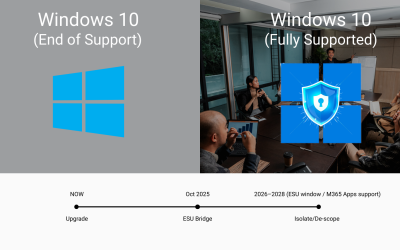
Let’s Be Honest About IT Costs
If you run a small business in the UK, you’ve probably wondered: “How much does proper IT support actually cost?” Maybe you’ve been hit with a surprise bill for a call-out, or you’ve spent hours wrestling with a stubborn laptop while your customers were waiting.
The truth is, many small business owners avoid looking too closely at IT costs until something breaks. But the real question isn’t just about the pounds and pence — it’s about value, predictability, and peace of mind.
In this blog, we’ll break down what IT support really costs in the UK, what you’re actually paying for, and how to make sure you’re getting the best deal for your business.
Why IT Support Matters More Than You Think
Before we get into the numbers, let’s step back. IT isn’t just about fixing computers when they stop working. It underpins everything — from taking payments and storing customer data to communicating with your team and keeping cyber threats at bay.
When IT fails, the cost isn’t just the invoice from your provider — it’s the lost sales, wasted staff time, and the stress of trying to put things right.
That’s why many UK businesses are moving away from the old “pay when it breaks” model and towards managed IT support — predictable monthly costs with proactive monitoring and ongoing improvements.
The Main IT Support Pricing Models in the UK
1. Break/Fix Support (Pay-As-You-Go)
- How it works: You only pay when something breaks — like calling a plumber when a pipe bursts.
- Cost: Hourly rates typically range from £75–£125 per hour, plus call-out charges.
- Pros: No ongoing commitment, handy if you rarely need help.
- Cons: Costs can spiral quickly in a crisis, no proactive monitoring, and downtime can be expensive.
2. Managed IT Support (Fixed Monthly Fee)
- How it works: You pay a monthly fee per user or device. The provider monitors, maintains, and supports your IT systems proactively.
- Cost: Usually £25–£75 per user per month, depending on the level of service.
- Pros: Predictable costs, proactive problem prevention, better security, ongoing advice.
- Cons: Commitment to a monthly fee (though this often saves money in the long run).
3. Hybrid Support
- How it works: A blend of managed services with some pay-as-you-go for extras.
- Cost: Base monthly fee (smaller than full managed) + hourly rates when needed.
- Pros: Flexibility, suits businesses with simple IT but occasional extra needs.
- Cons: Can still lead to unexpected costs if issues crop up often.
What’s Included in Managed IT Support?
When small business owners first see a per-user monthly fee, they sometimes think it’s steep. But let’s unpack what’s usually included:
- 24/7 monitoring of your systems (problems fixed before you even notice).
- Helpdesk support — quick fixes for everyday issues (e.g. email not working).
- Regular updates & patching to keep systems secure.
- Cybersecurity protection — antivirus, firewalls, backups.
- Strategic advice — helping you plan IT that supports your growth.
- Vendor management — dealing with Microsoft, broadband, or software providers so you don’t have to.
When you look at it that way, the monthly fee often works out cheaper than a single day of downtime.
The Hidden Costs of Not Having IT Support
Some businesses try to “make do” without professional IT support, thinking they’re saving money. But here’s what that can really cost:
- Staff downtime: If a team member spends two hours trying to fix their own laptop, that’s two hours of lost productivity. Multiply that across the year and it adds up.
- Data breaches: The average cost of a cyber-attack for a UK small business is £4,200 (according to the government’s Cyber Security Breaches Survey).
- Lost customers: If your systems are unreliable, customers may quietly take their business elsewhere.
- Unexpected repair bills: Emergency call-outs are almost always more expensive than proactive support.
How to Work Out What’s Right for Your Business
The best IT support plan depends on your business size, industry, and how you use technology.
Ask yourself:
- How many staff members need IT support?
- Do you handle sensitive customer data (finance, health, personal details)?
- How much downtime can you realistically afford?
- Do you want predictable monthly costs or are you comfortable with occasional big bills?
For most small businesses (5–50 staff), a fully managed IT support package gives the best balance of cost, security, and peace of mind.
Typical Costs for Small UK Businesses
To give you a ballpark:
- Micro business (1–5 users): £150–£500 per month.
- Small business (6–20 users): £300–£1,200 per month.
- Medium business (21–50 users): £800–£3,000 per month.
These figures vary depending on the complexity of your setup, the services included, and the provider’s expertise. But remember: if an IT issue prevents just one member of staff from working for a day, that could already cost more than your monthly support fee.
How to Spot a Good IT Support Deal
Not all IT providers are created equal. When comparing quotes, look for:
- Clear pricing (no hidden extras).
- Unlimited remote support (so you’re not charged for every little call).
- Proactive monitoring included as standard.
- Flexible contracts (avoid long lock-ins if you’re unsure).
- Local presence — someone who understands UK business realities.
IT Support Isn’t a Cost — It’s an Investment
So, how much does IT support really cost in the UK? The short answer: usually less than the cost of a single major IT disaster.
For most small businesses, a predictable monthly package not only keeps costs under control but also keeps your business running smoothly, securely, and stress-free.
At Harmony IT Services, we specialise in helping UK small businesses get the right support for their budget — no jargon, no hidden fees, just straightforward IT that works.
👉 Want to know exactly what IT support would cost for your business? Get in touch with our friendly team today — we’ll give you a clear, no-obligation quote and help you find the right fit.


0 Comments